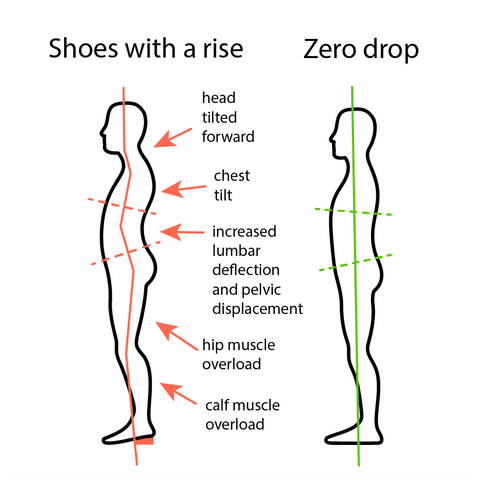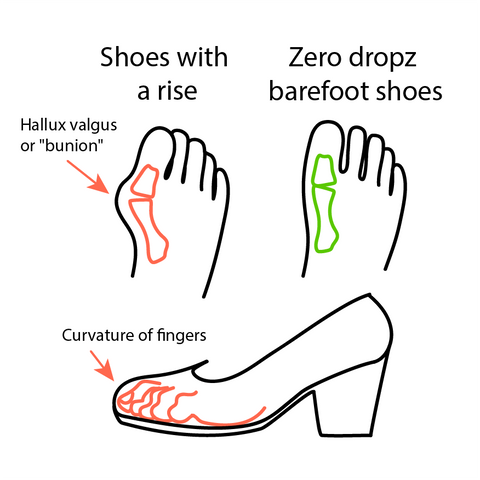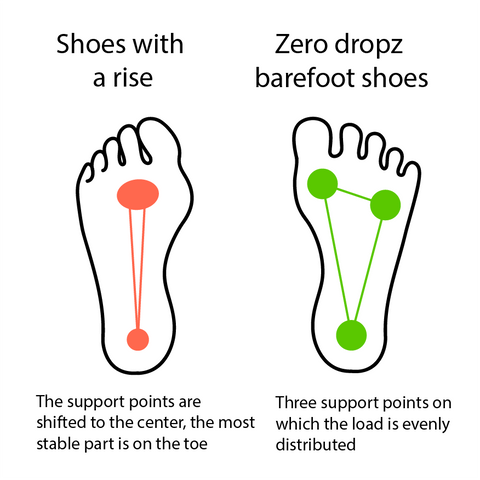Why do we wear heels at all?
Historically, heels first appeared in shoes not for fashion, but for function. In ancient Persia, horse riders used heels to keep their feet stable in stirrups. Later, heels became a status symbol in Europe, worn by aristocrats to signify wealth and power. Over time, they evolved into a fashion statement, symbolizing sophistication and elegance. Today, heels are a staple in many wardrobes, but even a small heel can impact our body more than we realize. This is why many are now switching to barefoot footwear or minimalist shoes, which allow the body to move as nature intended.
Why even a low heel can be harmful
1️⃣ Shifting the Center of Gravity
Even a 2–4 cm heel changes balance and weight distribution on the feet. The center of gravity shifts forward, causing the spine to compensate by adjusting into an unnatural position to maintain balance. A heel-to-toe drop, no matter how small, encourages unnatural posture: it tilts the pelvis forward, shortens the calf muscles, and places extra pressure on the forefoot. Over time, this can lead to knee pain, hip misalignment, and back discomfort. That’s why zero-drop shoes are often recommended by foot health specialists — they keep your feet flat on the ground, maintaining a more natural alignment.

2️⃣ Increased Pressure on the Ball of the Foot
A raised heel forces the front of the foot to take on extra load. Combined with narrow-toe shoes, this squeezes the toes and disrupts their natural alignment. This can lead to bunions, toe deformities, calluses, pain, and inflammation, especially in people prone to joint issues.


3️⃣ Calf Muscle Tension
Even a low heel puts constant tension on the calf muscles and tendons. The muscles remain slightly contracted, reducing flexibility. This can lead to muscle shortening and occasional cramps.
4️⃣ Knee Strain and Arthritis Risk
Low heels change the angle of the knees, forcing them to work in an unusual position and overloading the joint. Over time, this can wear down cartilage, leading to pain and increased risk of arthritis.
5️⃣ Disruption of Natural Foot Mechanics
A low heel disrupts the foot’s natural heel-to-toe roll, limiting tendon flexibility and weakening foot muscles. This reduces shock absorption and flexibility, leading to foot deformities and discomfort when walking.

Want to keep your posture and feet healthy?
Most people don’t realise how often they wear shoes with a slight heel—even common sneakers and boots. Making the transition to barefoot can feel like a big shift, but the benefits to your posture and long-term comfort are worth it.
Opt for zero-drop shoes—no difference in height between heel and toe! These models help maintain the foot’s natural position, support shock absorption, and promote balance.
That’s why we’re passionate about promoting foot-friendly shoes and designs that support natural movement and healthy feet. If you're just getting started, take a look at our collection for beginners - an easy way to ease into the barefoot lifestyle with supportive, stylish options. You can also check out our article on “How to Start Wearing Barefoot Shoes.”
Remember: health starts with small steps, and feet are our foundation!

